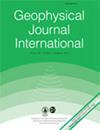Relationship between Cole-Cole model parameters in permittivity and conductivity formulation
IF 2.8
3区 地球科学
Q2 GEOCHEMISTRY & GEOPHYSICS
引用次数: 0
Abstract
Summary For the analysis of spectral induced polarization (SIP) measurements and for the description of frequency-dependent electrical relaxation responses, so-called Cole-Cole models (CCMs) are widely used. Typically, CCM formulations in terms of complex electrical conductivity or complex electrical resistivity are used in geophysical applications. The differences between these model descriptions, in particular between the respective time constants, and their conversion have been studied. A third variant of the model is formulated in terms of complex permittivity, commonly used in materials science. In general, all these model formulations can be used equivalently for fitting SIP data, which, however, results in differing values for some of the model parameters. For a meaningful comparison of CCM parameters of different samples or measurements, it is necessary that they are based on the same model formulation. In this work, the relationships between the Debye model (DM) and CCM parameters in the formulation for complex permittivity and complex conductivity are studied. A direct analytical conversion is possible for generalized DM formulations, both in single- and multi-term model formulations, resulting in relationships between the respective relaxation time distributions (RTDs). Such a direct conversion for CCM formulations is not possible. We however derived an approximate relationship between log -normal RTD and CCM formulations and respective permittivity and conductivity parameter values. Our study also highlights the significance of using consistent model formulations when experimental data are compared in terms of DM or CCM parameters, as parameters used to predict ice temperature are incorrect if the conductivity time constant is used to predict the temperature from interpolation of a permittivity time constant-temperature relationship.科尔-科尔模型参数在介电常数和电导率公式中的关系
摘要 在分析频谱诱导极化(SIP)测量和描述频率相关的电弛豫响应时,广泛使用所谓的科尔-科尔模型(CCM)。在地球物理应用中,通常使用复电导率或复电阻率的 CCM 公式。对这些模型描述之间的差异,特别是各自时间常数之间的差异及其转换进行了研究。该模型的第三种变体是以材料科学中常用的复介电常数来表述的。一般来说,所有这些模型公式都可等效用于拟合 SIP 数据,但这会导致某些模型参数值的不同。为了对不同样品或测量结果的 CCM 参数进行有意义的比较,它们必须基于相同的模型公式。在这项工作中,研究了德拜模型 (DM) 与复介电常数和复电导率公式中的 CCM 参数之间的关系。对于广义的 DM 公式,无论是单期还是多期模型公式,都可以进行直接分析转换,从而得出各自弛豫时间分布 (RTD) 之间的关系。而 CCM 配方则无法实现这种直接转换。不过,我们得出了对数正态 RTD 和 CCM 配方与各自的介电常数和电导率参数值之间的近似关系。我们的研究还强调了在根据 DM 或 CCM 参数对实验数据进行比较时,使用一致的模型公式的重要性,因为如果使用电导率时间常数通过对介电常数时间常数-温度关系的插值来预测温度,则用于预测冰温度的参数是不正确的。
本文章由计算机程序翻译,如有差异,请以英文原文为准。
求助全文
约1分钟内获得全文
求助全文
来源期刊

Geophysical Journal International
地学-地球化学与地球物理
CiteScore
5.40
自引率
10.70%
发文量
436
审稿时长
3.3 months
期刊介绍:
Geophysical Journal International publishes top quality research papers, express letters, invited review papers and book reviews on all aspects of theoretical, computational, applied and observational geophysics.
 求助内容:
求助内容: 应助结果提醒方式:
应助结果提醒方式:


